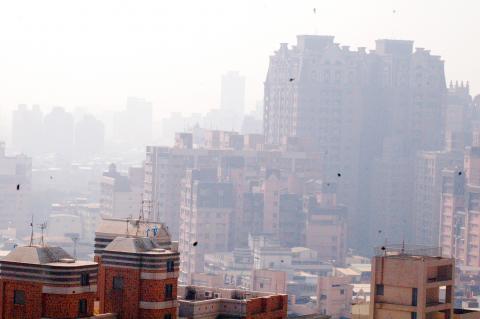The air pollution levels in all the nation’s cities and counties — except for Hualien and Taitung — failed to meet national standards for three consecutive years, thereby qualifying for the highest level in the Environmental Protection Administration’s (EPA) three-tier classification system for air-pollution-control zones.
The EPA yesterday released its monitoring data on PM2.5 — fine particulate matter measuring 25 micrometers in diameter or smaller — for the past three years, and only Hualien and Taitung had average PM2.5 levels lower than the EPA’s annual limit of 15 micrograms per cubic meter.
The national average PM2.5 concentration for the period was 23.1 micrograms per cubic meter, and Yunlin and Kinmen counties and Chiayi were the most polluted areas, with average PM2.5 concentrations of 33.3 micrograms per cubic meters, 31.5 micrograms and 32.7 micrograms respectively — more than double the EPA’s limit.

Photo: Huang Liang-chieh, Taipei Times
Under the EPA’s system, national parks and nature reserves are class-one air-pollution control zones; class-two zones are places where air quality meets national standards, while those areas where the air quality falls below standards for three years in a row are class-three zones.
The standards include indices of PM2.5, PM10, ozone, carbon dioxide, sulphur dioxide and nitrogen dioxide. Monitoring of PM2.5 levels began in 1997, but they were only included as an air quality index in 2012.
At present, only Kaohsiung and Pingtung are designated as a class-three zones due to their excessive PM10 and ozone levels.
This means that industries in the two locations are required to reduce emissions by 5 percent.
Taiwan Healthy Air Action Alliance founder Yeh Guang-peng (葉光芃) said that while the PM2.5 levels of many cities and counties were so high that it was clear by 2014 that these areas would quality as class-three zones by the end of last year, the EPA did not take steps to curb pollution.
The agency instead opted to allow pollution to continue at its current pace, Yeh said.
“Although three years of monitoring is the legal basis for designating control zones, the EPA should not be content to simply follow legal stipulations,” Yeh said.
“It should have taken proactive measures, designating these areas as class-three zones and implementing emergency measures to curb pollution,” Yeh said.
However, the EPA said the average PM2.5 and PM10 levels last year were 20 percent lower than those of 2008, and concentrations of traditional pollutants such as sulphur dioxide and nitrogen dioxide also dropped by more than 20 percent.
It has established more than 200 sets of regulations to control industrial and traffic emissions, the agency said.
It said it was also working to facilitate the replacement of outdated and energy-intensive facilities to lower the national PM2.5 level to 15 micrograms per cubic meter by 2020.

Tropical Storm Gaemi strengthened into a typhoon at 2pm yesterday, and could make landfall in Yilan County tomorrow, the Central Weather Administration (CWA) said yesterday. The agency was scheduled to issue a sea warning at 11:30pm yesterday, and could issue a land warning later today. Gaemi was moving north-northwest at 4kph, carrying maximum sustained winds near its center of up to 118.8kph and gusts of 154.8kph. The circumference is forecast to reach eastern Taiwan tomorrow morning, with the center making landfall in Yilan County later that night before departing from the north coast, CWA weather forecaster Kuan Shin-ping (官欣平) said yesterday. Uncertainty remains and

SEA WARNING LIKELY: The storm, named Gaemi, could become a moderate typhoon on Wednesday or Thursday, with the Taipei City Government preparing for flooding A tropical depression east of the Philippines developed into a tropical storm named Gaemi at 2pm yesterday, and was moving toward eastern Taiwan, the Central Weather Administration (CWA) said. Gaemi could begin to affect Taiwan proper on Tuesday, lasting until Friday, and could develop into a moderate typhoon on Wednesday or Thursday, it said. A sea warning for Gaemi could be issued as early as Tuesday morning, it added. Gaemi, the third tropical storm in the Pacific Ocean this typhoon season, is projected to begin moving northwest today, and be closest to Taiwan on Wednesday or Thursday, the agency said. Today, there would likely

DISRUPTIONS: The high-speed rail is to operate as normal, while several airlines either canceled flights or announced early departures or late arrivals Schools and offices in 15 cities and counties are to be closed today due to Typhoon Gaemi, local governments announced last night. The 15 are: Taipei, New Taipei City, Taoyuan, Tainan, Keelung, Hsinchu and Kaohsiung, as well as Yilan, Hualien, Hsinchu, Miaoli, Chiayi, Pingtung, Penghu and Lienchiang counties. People should brace for torrential rainfall brought by the storm, with its center forecast to make landfall on the east coast between tonight and tomorrow morning, the Central Weather Administration (CWA) said. The agency issued a sea warning for the typhoon at 11:30pm on Monday, followed by a land warning at 11:30am yesterday. As of

CASUALTY: A 70-year-old woman was killed by a falling tree in Kaohsiung as the premier warned all government agencies to remain on high alert for the next 24 hours Schools and offices nationwide are to be closed for a second day today as Typhoon Gaemi crosses over the nation, bringing torrential rain and whipping winds. Gaemi was forecast to make landfall late last night. From Tuesday night, its outer band brought substantial rainfall and strong winds to the nation. As of 6:15pm last night, the typhoon’s center was 20km southeast of Hualien County, Central Weather Administration (CWA) data showed. It was moving at 19kph and had a radius of 250km. As of 3pm yesterday, one woman had died, while 58 people were injured, the Central Emergency Operation Center said. The 70-year-old